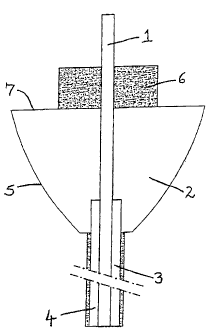Some of the information on this Web page has been provided by external sources. The Government of Canada is not responsible for the accuracy, reliability or currency of the information supplied by external sources. Users wishing to rely upon this information should consult directly with the source of the information. Content provided by external sources is not subject to official languages, privacy and accessibility requirements.
Any discrepancies in the text and image of the Claims and Abstract are due to differing posting times. Text of the Claims and Abstract are posted:
| (12) Patent: | (11) CA 2366544 |
|---|---|
| (54) English Title: | PLUG MEMBERS FOR STEEL FURNACES |
| (54) French Title: | OBTURATEUR POUR FOURS A ACIER |
| Status: | Deemed expired |
| (51) International Patent Classification (IPC): |
|
|---|---|
| (72) Inventors : |
|
| (73) Owners : |
|
| (71) Applicants : |
|
| (74) Agent: | OSLER, HOSKIN & HARCOURT LLP |
| (74) Associate agent: | |
| (45) Issued: | 2005-06-28 |
| (86) PCT Filing Date: | 2001-02-08 |
| (87) Open to Public Inspection: | 2001-08-16 |
| Examination requested: | 2001-09-05 |
| Availability of licence: | N/A |
| (25) Language of filing: | English |
| Patent Cooperation Treaty (PCT): | Yes |
|---|---|
| (86) PCT Filing Number: | PCT/GB2001/000476 |
| (87) International Publication Number: | WO2001/059383 |
| (85) National Entry: | 2001-09-05 |
| (30) Application Priority Data: | ||||||
|---|---|---|---|---|---|---|
|
A dart has a metal bar (1) passing through a
ceramic, shaped, dart head (2) and then through a cylindrical
ceramic dart stem (3). A sleeve (4) of a carbonaceous or reac-
tive material is provided about the stem (3) or a layer of that
material can be formed on the lower face (5) of the dart head
(2) (at the interface of the steel and slag). A block or sleeve (6)
of suitable reactive material could be positioned on the top face
(7) of the dart. The reactive material could be cardboard or pa-
per, or a reactive metal, such as aluminium or magnesium. In
each case a chemical reaction with the molten steel will result
in an updraft in the steel which clears slag from the area of the
tap hole.
une flèche possède une barre (1) métallique qui passe à travers une tête (2) de flèche de céramique en forme puis à travers une tige (3) de flèche de céramique cylindrique. Une gaine (4) de matériau charbonneux ou réactif recouvre cette tige (3) ou encore, on peut former une couche de ce matériau sur la face antérieure (5) de cette tête (2) de flèche (à l'interface de l'acier et des scories). On pourrait positionner un bloc ou une gaine (6) du réactif adapté sur la face supérieure (7) de cette flèche. Ce matériau réactif pourrait être du carton ou du papier, ou un métal réactif, tel que l'aluminium ou le magnésium. Dans chaque cas une réaction chimique avec l'acier fondu aura pour effet de générer une circulation ascendante dans l'acier qui élimine les scories de la région du trou de coulée.
Note: Claims are shown in the official language in which they were submitted.
Note: Descriptions are shown in the official language in which they were submitted.

For a clearer understanding of the status of the application/patent presented on this page, the site Disclaimer , as well as the definitions for Patent , Administrative Status , Maintenance Fee and Payment History should be consulted.
| Title | Date |
|---|---|
| Forecasted Issue Date | 2005-06-28 |
| (86) PCT Filing Date | 2001-02-08 |
| (87) PCT Publication Date | 2001-08-16 |
| (85) National Entry | 2001-09-05 |
| Examination Requested | 2001-09-05 |
| (45) Issued | 2005-06-28 |
| Deemed Expired | 2007-02-08 |
There is no abandonment history.
| Fee Type | Anniversary Year | Due Date | Amount Paid | Paid Date |
|---|---|---|---|---|
| Request for Examination | $400.00 | 2001-09-05 | ||
| Application Fee | $300.00 | 2001-09-05 | ||
| Registration of a document - section 124 | $100.00 | 2002-04-24 | ||
| Maintenance Fee - Application - New Act | 2 | 2003-02-10 | $100.00 | 2003-02-04 |
| Maintenance Fee - Application - New Act | 3 | 2004-02-09 | $100.00 | 2004-01-28 |
| Maintenance Fee - Application - New Act | 4 | 2005-02-08 | $100.00 | 2005-02-08 |
| Final Fee | $300.00 | 2005-04-14 |
Note: Records showing the ownership history in alphabetical order.
| Current Owners on Record |
|---|
| GORICON METALLURGICAL SERVICES LIMITED |
| Past Owners on Record |
|---|
| PURCHASE, WYNNE |